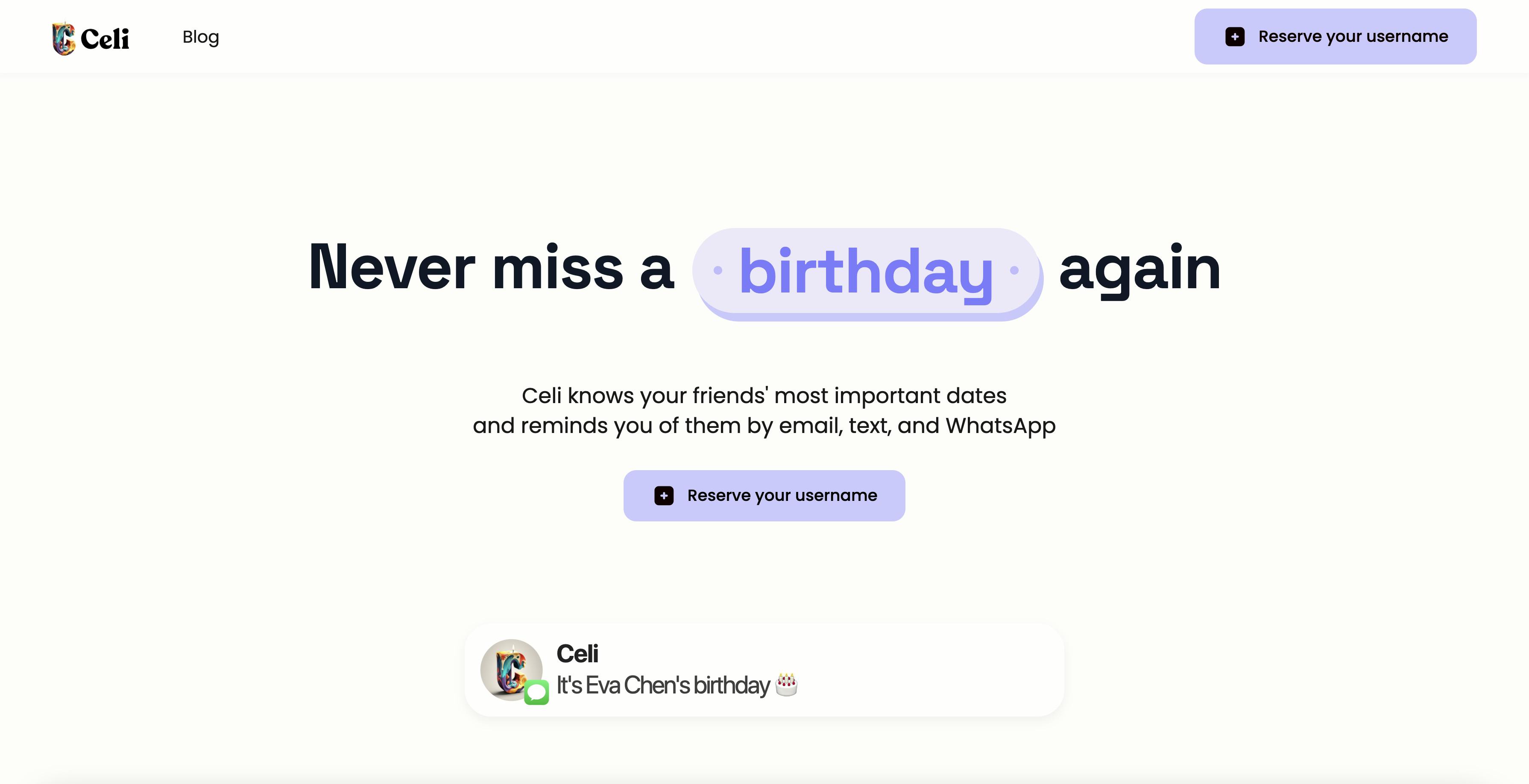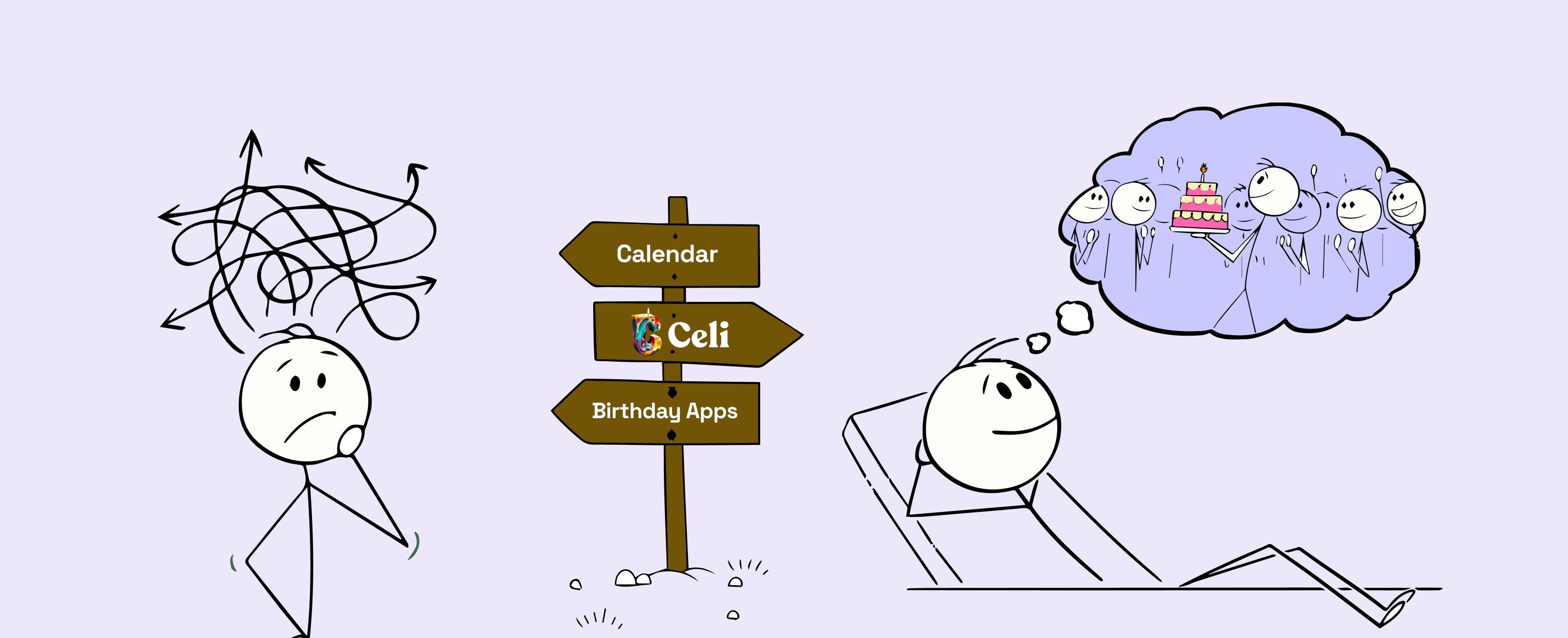- In Public
- Posts
- Everything, before anything
Everything, before anything
My step by step plan to de-risk Celi, from pain point to product
This piece has an opinion.
A point of view.
Since I last wrote you, Celi has celebrated 102 events and sent 1,411 notifications to 182 active users.
In early December, Celi’s original Full Stack Developer accepted a full-time role.
December then competed with holidays to find, interview, and hire a replacement.
January was devoted to onboarding and bringing that developer up to speed.
February is for full speed and putting the finishing touches on Celi.
Nicolas Correa Restrepo is an upgrade to Celi.
During this time, other adjustments helped Celi reduce its fixed costs by 48%, and double our runway.
If you’re tracking Celi for investment, please read this as “Ricki is an extremely responsible steward of capital.”
If you’re tracking Celi for daily use, give me 6 more weeks.
If you haven’t claimed your username, now would be a good time to do so ⬇️.
Everything, before anything
Law 29 of the 48 Laws of Power is Plan all the way to the end.
Robert Greene writes, “By planning to the end you will not be overwhelmed by circumstances. You’ll gently guide fortune and help determine the future by thinking far ahead.”
The second of Stephen Covey’s 7 Habits of Highly Effective People is to begin with the end in mind. Define your mission, goals, and priorities clearly to guide your decisions.
If my goal is to build Celi into a sustainable standalone business in 2024, I can reverse engineer my way there and progressively meet each milestone:
Before monetization, growth
Before growth, product-market fit
Before product-market fit, product
Before product, MVP
Before MVP, thesis
Before thesis, their pain
Before their pain, personal pain
Before their pain, personal pain
When Lenny Rachitsky explored the fundamental steps of kickstarting and scaling a consumer business, he learned that the #1 strategy for coming up with a great startup idea was a founder who set out to solve their own problem.
As Paul Graham put it, “Working on problems you have yourself, particularly ones that chafe you, ensures the problem really exists.”
When I started incubating Celi, I wasn’t trying to start a company.
I was just trying to have Thanksgiving dinner.
Two holidays ago, I walked into my Aunt Sindi’s house and saw 3 birthday cakes.
I asked her who they were for.
She told me my sister, my Nonna, and my cousin Matt.
News to me.
I walked over to my sister to wish her a happy belated birthday.
Surprised, she told me I hadn’t remembered in years.
Personal pain point.
Fast forward to December 28th, 2022, my 5 year soberversary.
I’m extremely proud of my sobriety, and would have loved to celebrate this with friends and family. It’s their success as much as mine.
That day was filled with silence.
Personal pain point.
For the next few months, I sat with this and brainstormed how I might solve these personal pain points, and which others might exist.
Celi didn’t begin with a founder trying to think of startup ideas.
Celi started with a problem experienced by its founder.
But, is that enough?
Before thesis, their pain
Being the only person to experience a problem is not enough to build a company.
First Round Capital’s Todd Jackson encourages founders to “start with a problem you’ve experienced firsthand and figure out if enough other people have the same problem.”
This is to make sure we’re building something significant enough.
To confirm if we have either of the prerequisites: Mass market or mass problem.
A huge problem with a small market is a high-value product.
A small problem with a huge market is a mass consumer product.
Celi is the latter.
We found this out from The Celi Survey, which was designed to triple verify the pain point.
It sought to:
Validate the existence of the problem
Validate that others have tried and failed to solve this themselves
Validate if people with this pain still want to solve this
We also wanted to overcome false positives from friends and family who encourage ambitious projects without providing a time, money, or reputation risk, and are often unqualified.
From the Celi Survey, we learned that:
92% of people have forgotten a birthday
76% of people have forgotten a friend's important life date
75% have tried and failed to solve these problems
89% of people want to solve these problems
They’d pay $25 annually to solve this problem
This, along with everything else we learned from using a Typeform survey to build a company, was enough to advance us to the thesis stage.
Before MVP, thesis
The beauty of validating their pain is that you develop a list of real users to learn from.
In conversations, we learned that we had to solve two problems:
Knowing important dates
Remembering important dates
Remembering important dates is simple.
Think of your digital calendar. When a scheduled event approaches or arrives, you receive a notification.
But, how does your digital calendar know these events?
At some point in time, a human would have created an event and input the necessary information.
When it comes to your local network’s most important dates, this was the larger pain point.
We learned that no one knew all of their local network’s birthdays, never mind their beyond-the-birthday dates, and most were unwilling to perform the manual effort to collect and input these dates.
Facebook used to solve this before hitting a carrying capacity. Instagram has a birthday feature that few use. Apple contacts sync is flawed. The manual effort of a digital calendar has too many points of failure and omissions.
Celi had an opportunity to prioritize what Apple, Google, and Amazon products do: Solve a user’s problem faster, with less effort.
Celi’s first thesis was a single-player product that automated the collection of your local network’s most important dates.
You, as the Celi user, would have a unique shareable link ( timetoceli.com/yourname ) that you could send to friends, family, and co-workers. They open the link, enter their information and important dates, and press submit. Once they submit their info, Celi creates recurring events on your calendar for each date, with all the details you’d need.
This would solve my pain point.
It wouldn’t solve anyone else’s.
It would create more irritation and lead to product cannibalization.
Should that same friend be asked to fill out the form again next week, or next week, they’ll become annoyed at the redundancy.
The single-player thesis also prevents Celi from creating the perfect business: Virality plus monetization.
The idea of a unique shareable link that you can use for information collection is fantastic though.
Consider what Postable built to make getting your friend’s addresses easy.
For Celi’s second and current thesis, we expanded on the unique shareable link.
You can create a Celi account in one of two ways:
From our site (organic)
From a current user’s PAC link (referral)
On Celi, when you send someone your PAC Link (pre-approved connection link), and they submit their information, we save their information and create their account. Then, we create a bi-directional connection between your profiles so your dates sync to each other’s notification system and neither of you miss a moment again.
When the person you sent your unique link to is sent another one next week, they can skip the entry process and just log in and make the connection - no need to duplicate efforts.
This evolves Celi from a single-player product to a multi-player networked product.
Networked products, network effects.

Celi dashboard view displaying the PAC link

PAC link landing page
Before product, MVP
MVP stands for "Minimum Viable Product". It refers to a development technique in which a new product or website is developed with enough features to satisfy early adopters and test the thesis.
The key aspects of an MVP include:
Core product functionality
Value delivery to customers
Enough features to deploy and distribute the product
The advantages of launching an MVP are:
Reduced time to market
Lower development costs
Ability to gather real feedback that guides future development early
An MVP allows a product to be launched early, tested with customers, and improved iteratively based on real market feedback.
For Celi’s MVP I represented the technology.
Celi’s MVP ran for 20 weeks and closed with the following data:
163 monthly active users
10% week-over-week growth
2.52 viral coefficient
91% activation rate
76% engagement rate
28 atomic networks
At the individual level, Celi saw:
3.7 dates per user
15.3 connections per user
71% of Celi users list 2+ dates on their profile
54% of Celi users list 3+ dates on their profile
32% of Celi users list 4+ dates on their profile
The most popular beyond-the-birthday dates were:
Anniversary (on 59% of profiles)
Remembrance Day (on 30% of profiles)
Child’s Birthday (on 27% of profiles)
Pet’s Birthday (on 23% of profiles)
Workiversary (on 18% of profiles)
We also learned that:
91% of users would be somewhat or very disappointed if they couldn’t use Celi anymore
37% of users consider Celi to be a must-have
55% of users have found magic in Celi
Then we received 14 testimonials that describe Celi better than I could.
It was time to build the real product.
Before product-market fit, product
A minimal marketable product (MMP) is a version of a product that has just enough features to be viable for sale in the market.
Key characteristics of an MMP include:
It meets the minimal needs of early adopters and innovators who make up the first market
It has enough features and functionality to be deployable, usable, and sellable
It establishes the core value proposition and product concept with a small viable feature set
MMPs exclude extraneous features that enhance the customer experience but are not essential for early sales. These can be added later based on feedback and performance data.
This is where Celi is today.
In a mentor session, I was advised to launch Celi only when a user can do everything they’d want to do.
The specific advice was “Don’t let anyone be frustrated by something they can’t do. Launch when it works and can spread without you.”
For Celi, that moment is when anyone, anywhere, can create an account, connect with or invite people to Celi, and then receive email, SMS, and WhatsApp notifications that celi their connections.
Getting here has provided the opportunity to determine Celi’s product DNA.
Beginning at account creation, we’ve restricted Celi to having only necessary forms of friction that set a new user up for success.
Or, as Oji Udezue put it we made mandatory the tasks that if they were optional, would result in users’ failing.
Then we decided which founding beyond-the-birthday dates to include.
Even which features we should prioritize to accelerate product-led acquisition.
These and more are what you’ll be able to experience in a few weeks.
If you want to be first, claim your username below:
Before growth, product market fit
In Before Growth, Sam Altman says that “until users love a product so much that they spontaneously tell others to use it, then founders are generally better off focusing here instead of a growth target.”
During this stage, we’ll interview users and evaluate data with the help of Mixpanel or June.
Product-market fit refers to the degree to which a product satisfies a strong market demand or solves a major pain point for customers.
While some argue you’ve reached product-market fit when over 40% of your users would be “very disappointed” without your product, I believe that to be a loose metric.
Already, 91% of users would be somewhat or very disappointed if they couldn’t use Celi.
While Celi may have pre-product-market fit signals, we have quite a way to go.
Product-market fit is elusive.
It’s a mix of exponential organic growth, retention, and user feedback.
It’s also the only thing that matters.
For Celi, beyond the recommendations, we’ll measure product-market fit with our viral coefficient, key actions taken on the platform, and yet-to-be-defined activation metrics that capture the magic happening outside of Celi.
Before monetization, growth
Once we have product-market fit, we can focus on growth.
But, if we’ve built Celi right, we won’t need to.
Celi’s growth engine is virality, which means existing users acquire new users on Celi’s behalf.
In Product > Strategy > Business Model, Fred Wilson wrote “One of the mistakes I see entrepreneurs make is they move to business model before locking down strategy. Get the product right first, then lock down the strategy of the business, then figure out the business model.”
Without fail, every time I introduce Celi to someone they ask “How does it make money.”
Sigh.
While yes, I have plans to pursue each of the 5 pillars that underpin billions of dollars of consumer value, spending time on this now is a distraction.
If you have a great monetization plan but a shitty product, you won’t need a great monetization plan, because you won’t have customers to monetize.
When the time comes, Celi will monetize, slowly.
We’ll start by asking users “What would you pay for?”
Until then, product remains the focus, as does, seeding Celi’s distribution advantage.
Playing entrepreneur
“When the roots are deep, there's no reason to fear the wind” is the African proverb guiding Celi’s development.
I’m bootstrapping Celi, meaning I incur every expense from subscription to salary.
Creating a ladder of milestones not only forms a firm foundation, but it de-risks Celi for me.
Only by reaching a milestone, does Celi grant our team permission to advance to the next.
I’m not building Celi to play entrepreneur.
I’m building it to solve my problems.
Your problems.
Our problems.
Getting there requires doing everything, before anything.



